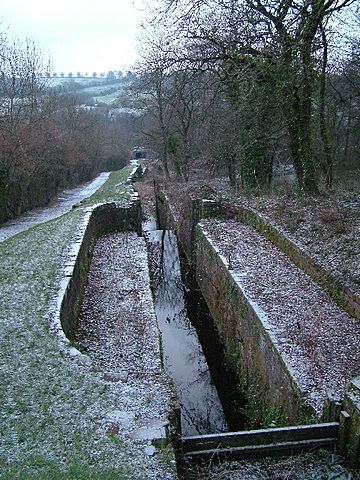Fourteen Locks facts for kids

Lock 11, February 2005. The upper part of this lock was made wider, to allow boats to pass.
|
|
| Waterway | Crumlin Arm (Monmouthshire canal) |
|---|---|
| Operation | Manual |
| First built | 1799 |
| Length | 64 feet 9 inches (19.7 m) |
| Width | 9 feet 2 inches (2.79 m) |
| Fall | 160 feet (49 m) |
| Partially restored | |
The Fourteen Locks are a special series of canal locks in Newport, South Wales. They are also known as the Cefn Flight. These locks are part of the Crumlin arm of the Monmouthshire Canal.
This amazing set of locks was finished in 1799. It helps boats climb a huge 160 feet (50 meters) in a very short distance, only 800 yards (740 meters)! This makes it one of the steepest and most important lock systems in the whole United Kingdom. The Fourteen Locks are designed as a "flight of locks," meaning each lock has its own gates, unlike a "staircase" where gates are shared.
Contents
What are the Fourteen Locks?
A canal lock is like a water elevator for boats. It helps boats move up or down between different water levels. The Fourteen Locks are a long series of these water elevators. They were built to help boats carry goods like coal and iron up and down a steep hill.
This system includes special ponds, channels, and gates. These parts work together to control the water. They make sure there's enough water for each boat to pass through.
Building the Canal: A Look Back
The idea for the Monmouthshire Canal started in June 1792. A special law was passed to allow its construction. The canal had a main route and a branch. The branch, called the Crumlin Branch, is where the Fourteen Locks are located.
The main canal had 41 locks and rose 435 feet (133 meters). The Crumlin Branch had 32 locks and rose 358 feet (109 meters). The Rogerstone flight, which is the Fourteen Locks, had the most locks on the Crumlin Branch.
Who Designed the Locks?
Thomas Dadford, Jr. was the engineer who designed this huge project. He was also working on other canals at the same time. The canal was built in stages. By February 1796, most of the main canal was open. The company announced that all the work was finished in April 1799.
Dadford's design for the Rogerstone Locks was a big achievement. The locks were very close together. To solve this, he added "side ponds." These ponds helped keep the water levels steady when boats moved through the locks.
How Did the Locks Work?
The canal was not connected to other canals in Britain. This meant Dadford could choose the size of the locks. The first boats were about 62 feet (19 meters) long and 8 feet (2.7 meters) wide. Soon, boats became a bit bigger, about 64 feet (19.7 meters) long and 9 feet (2.8 meters) wide. These larger boats could carry 25 to 28 tons of goods.
The locks are arranged in a clever way. There are five pairs of locks, and then a group of three (locks 10, 11, and 12). Lock 21 is on its own at the very top. This design helped boats climb the steep hill efficiently.
The Canal's Later Years
The Monmouthshire Canal was part of a larger network. This network included many tram roads, which were like early railways. Over time, these tram roads were improved for locomotives. By 1865, the canal was not used much for carrying goods. People preferred to use the railways.
In 1880, the canal became part of the Great Western Railway company. Parts of the canal were closed in 1909. The rest of the Crumlin Branch was officially closed in 1949. By 1950, the locks were no longer working, and the canal was full of weeds.
Bringing the Locks Back to Life
Efforts to restore parts of the canal system began in 1961. However, people didn't focus on the Monmouthshire Canal until 1965. Groups like the Inland Waterways Association started campaigning to protect the canal's remains.
In 1967, the Newport (Monmouthshire) Canal Society was formed. They pushed for the canal to be restored. Volunteers started working on the Crumlin Branch in March 1969.
Helping Hands: Volunteer Efforts
The first major repair work on the Fourteen Locks happened in early 2003. Cefn Lock was fixed. This allowed a special trip-boat to run on a small part of the canal. For a while, only the very top lock had water.
In March 2007, a big grant of £700,000 was given by the Heritage Lottery Fund. This money helped restore the next four locks at the top of the flight. Work on locks 20, 19, 18, and 17 began in 2010 and was finished in 2011.
The Visitor Centre Today
The Fourteen Locks Canal and Conference Centre is located right next to the canal. It's a great place to learn about the canal's history. The centre has exhibits, shows local art, and has a meeting room. There's also a tea room where visitors can relax.
The centre offers guided walks along the canal. In its first three years, the centre welcomed 150,000 visitors! It continues to be a popular spot for people to explore and learn about this historic waterway.

